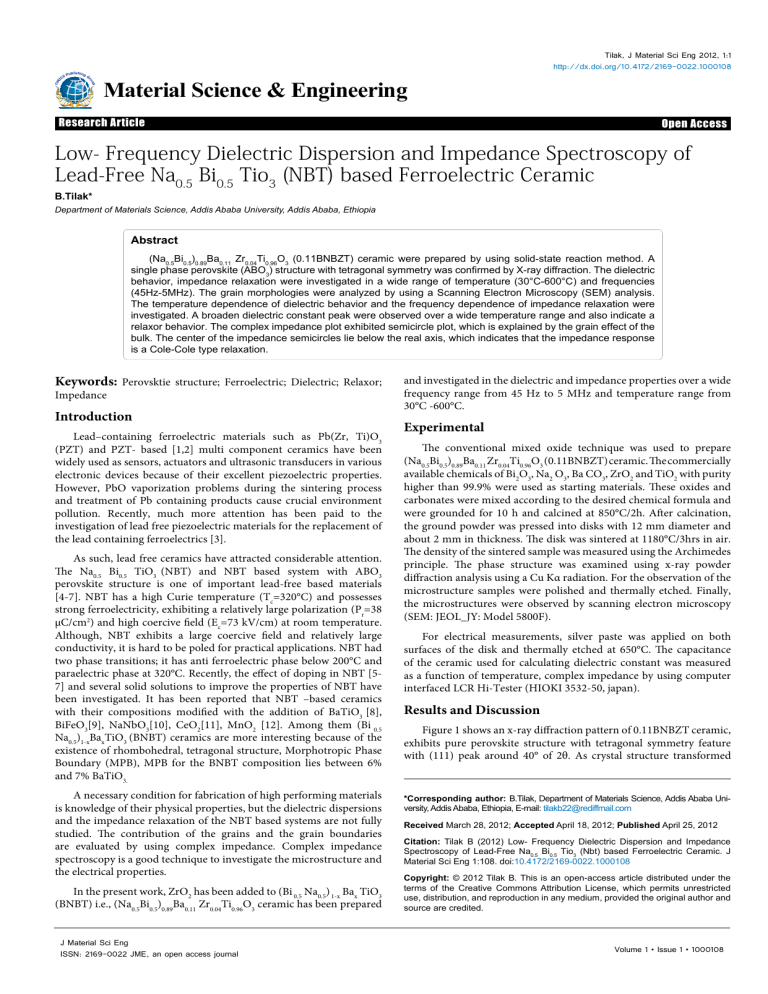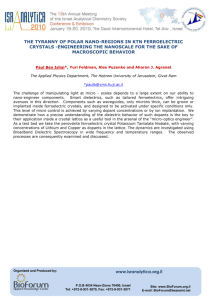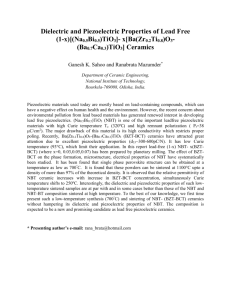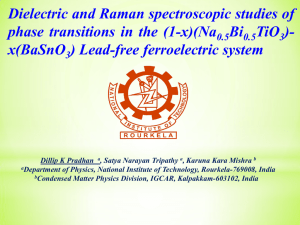View PDF - OMICS International

Tilak, J Material Sci Eng 2012, 1:1 http://dx.doi.org/10.4172/2169-0022.1000108
Material Science & Engineering
Low- Frequency Dielectric Dispersion and Impedance Spectroscopy of
Lead-Free Na
B.Tilak*
0.5
Bi
0.5
Tio
3
(NBT) based Ferroelectric Ceramic
Department of Materials Science, Addis Ababa University, Addis Ababa, Ethiopia
Abstract
(Na
0.5
Bi
0.5
)
0.89
Ba
0.11
Zr
0.04
Ti single phase perovskite (ABO
0.96
3
O
3
(0.11BNBZT) ceramic were prepared by using solid-state reaction method. A
) structure with tetragonal symmetry was confirmed by X-ray diffraction. The dielectric behavior, impedance relaxation were investigated in a wide range of temperature (30°C-600°C) and frequencies
(45Hz-5MHz). The grain morphologies were analyzed by using a Scanning Electron Microscopy (SEM) analysis.
The temperature dependence of dielectric behavior and the frequency dependence of impedance relaxation were investigated. A broaden dielectric constant peak were observed over a wide temperature range and also indicate a relaxor behavior. The complex impedance plot exhibited semicircle plot, which is explained by the grain effect of the bulk. The center of the impedance semicircles lie below the real axis, which indicates that the impedance response is a Cole-Cole type relaxation.
Keywords:
Perovsktie structure; Ferroelectric; Dielectric; Relaxor;
Impedance
Introduction
Lead–containing ferroelectric materials such as Pb(Zr, Ti)O
(PZT) and PZT- based [1,2] multi component ceramics have been
3 widely used as sensors, actuators and ultrasonic transducers in various electronic devices because of their excellent piezoelectric properties.
However, PbO vaporization problems during the sintering process and treatment of Pb containing products cause crucial environment pollution. Recently, much more attention has been paid to the investigation of lead free piezoelectric materials for the replacement of the lead containing ferroelectrics [3].
As such, lead free ceramics have attracted considerable attention.
The Na
0.5
Bi TiO
3
(NBT) and NBT based system with ABO perovskite structure is one of important lead-free based materials
[4-7]. NBT has a high Curie temperature (T
3
µC/cm 2 ) and high coercive field (E c c
=320°C) and possesses strong ferroelectricity, exhibiting a relatively large polarization (P r
=38
=73 kV/cm) at room temperature.
Although, NBT exhibits a large coercive field and relatively large conductivity, it is hard to be poled for practical applications. NBT had two phase transitions; it has anti ferroelectric phase below 200°C and paraelectric phase at 320°C. Recently, the effect of doping in NBT [5-
7] and several solid solutions to improve the properties of NBT have been investigated. It has been reported that NBT –based ceramics with their compositions modified with the addition of BaTiO
BiFeO
3
[9], NaNbO
3
[10], CeO
2
[11], MnO
2
3
[8],
[12]. Among them (Bi
Na
0.5
)
1-x
Ba x
TiO
3
0.5
(BNBT) ceramics are more interesting because of the
Boundary (MPB), MPB for the BNBT composition lies between 6% and 7% BaTiO
3.
A necessary condition for fabrication of high performing materials is knowledge of their physical properties, but the dielectric dispersions and the impedance relaxation of the NBT based systems are not fully studied. The contribution of the grains and the grain boundaries are evaluated by using complex impedance. Complex impedance spectroscopy is a good technique to investigate the microstructure and the electrical properties.
In the present work, ZrO
2
(BNBT) i.e., (Na
0.5
Bi
0.5
)
0.89
Ba
has been added to (Bi
0.11
Zr
0.04
Ti
0.96
O
3
0.5
Na
0.5
)
1-x
Ba x
TiO
3 and investigated in the dielectric and impedance properties over a wide frequency range from 45 Hz to 5 MHz and temperature range from
30°C -600°C.
Experimental
(Na
The conventional mixed oxide technique was used to prepare
Bi
0.5
)
0.89
Ba
0.11
Zr
0.04
Ti
0.96
available chemicals of Bi
2
O
3
O
3
(0.11BNBZT) ceramic. The commercially
, Na
2
O
3
, Ba CO
3
, ZrO
2
and TiO
2
with purity higher than 99.9% were used as starting materials. These oxides and carbonates were mixed according to the desired chemical formula and were grounded for 10 h and calcined at 850°C/2h. After calcination, the ground powder was pressed into disks with 12 mm diameter and about 2 mm in thickness. The disk was sintered at 1180°C/3hrs in air.
The density of the sintered sample was measured using the Archimedes principle. The phase structure was examined using x-ray powder diffraction analysis using a Cu Kα radiation. For the observation of the microstructure samples were polished and thermally etched. Finally, the microstructures were observed by scanning electron microscopy
(SEM: JEOL_JY: Model 5800F).
For electrical measurements, silver paste was applied on both surfaces of the disk and thermally etched at 650°C. The capacitance of the ceramic used for calculating dielectric constant was measured as a function of temperature, complex impedance by using computer interfaced LCR Hi-Tester (HIOKI 3532-50, japan).
Results and Discussion
Figure 1 shows an x-ray diffraction pattern of 0.11BNBZT ceramic, exhibits pure perovskite structure with tetragonal symmetry feature with (111) peak around 40° of 2θ. As crystal structure transformed
*Corresponding author: B.Tilak, Department of Materials Science, Addis Ababa University, Addis Ababa, Ethiopia, E-mail: tilakb22@rediffmail.com
Received March 28, 2012; Accepted April 18, 2012; Published April 25, 2012
Citation: Tilak B (2012) Low- Frequency Dielectric Dispersion and Impedance
Spectroscopy of Lead-Free Na
0.5
Bi
0.5
Tio
3
(Nbt) based Ferroelectric Ceramic. J
Material Sci Eng 1:108. doi: 10.4172/2169-0022.1000108
Copyright: © 2012 Tilak B. This is an open-access article distributed under the terms of the Creative Commons Attribution License, which permits unrestricted use, distribution, and reproduction in any medium, provided the original author and source are credited.
J Material Sci Eng
ISSN: 2169-0022 JME, an open access journal
Volume 1 • Issue 1 • 1000108
Citation: Tilak B (2012) Low- Frequency Dielectric Dispersion and Impedance Spectroscopy of Lead-Free Na
Ceramic. J Material Sci Eng 1:108. doi: 10.4172/2169-0022.1000108
0.5
Bi
0.5
Tio
3
(Nbt) based Ferroelectric from rhombohedral into a tetragonal symmetry there is splitting of
(200) and (002) peak around 46.5° of 2θ, which has been observed in
XRD pattern (Figure 1). Lattice parameters have been calculated by using POWD software. Lattice parameters, cell volume, experimental and theoretical density, porosity has been tabulated in Table 1.
The scanning electron micrograph of the sintered ceramic
(011BNBZT) is shown in Figure 2, indicating that the ceramic is highly dense with less porosity. Based on the measurement of Archimedes principle, the experimental density of ceramic is 95% of theoretical density. The average grain size has been calculated by using line intercept method. The average grain size of the studied ceramic is1.21
µm.
Figure 3; depict the temperature dependence of real part of dielectric constant of 0.11BNBZT at various frequencies, indicating a relaxor like behavior [13]. At low frequencies, a phase transition from ferroelectric to anti ferroelectric is observed at around 100°C which is referred as depolarization temperature. Such type of transition was also reported in BNT-NNT-BT [14], BNT- PbTiO
3
[15] and BNT-BKT-BLT
[16] ceramics. But, with an increase of frequency, the ceramics show pure ferroelectric behaviors up to their transition temperatures. Such as, phenomenon might be probably due to cation disorder by random distribution of Na + , Bi + and Ba 2+ at the A-sites of the lattice [17-19].
There is an existence of three phases of ferroelectric, anti ferroelectric and paraelectric in different temperature ranges.
The dielectric constant has frequency dependence especially, at the low frequencies, which is called the low frequency dielectric dispersion.
A strong low-frequency dielectric dispersion has also been observed in NBT which was previously reported [20]. At temperature above T m and at low frequencies, the dispersion is increased, which is caused by an increase in the electrical conductivity. The dielectric peak appears to broaden with respect to increase in frequency which may be attributed to the structural disorder in the system. The real part of the dielectric constant, describes the “elastic” loss-free reaction of the material to an externally applied ac electric field.
Impedance spectroscopy
The electrical properties of the materials have been investigated using Complex Impedance Spectroscopy (CIS). It is an important tool to analyze the electrical properties of a polycrystalline material in view of its capability of correlating the sample electrical behavior to its microstructure [21].
Figure 4 represents the real part of impedance (Z 1 ) as function of frequency. Z 1 has higher values at lower frequency and decreases up to
100 kHz and attains a constant value beyond that. The pattern shows the sigmoidal variation as a function of frequency in the low frequency region followed by a saturation region in the frequency region. This suggests the presence of mixed nature of polarization behavior in the material.
Figure 5 presents the variation of imaginary part of impedance (Z 11 ) as a function of frequency at different set of temperatures. With the increase of frequency, the real part of impedance (Z 1 ) and imaginary part of impedance (Z 11 ) decreases with increase in frequency. At higher frequency side all the curves merge. As the temperature increases the peak has been observed in (Z 11 ) vs frequency curve [22]. The peak shifts towards higher frequency side with increasing temperature showing that the resistance of the bulk material is decreasing. Also, the magnitude of Z 11 decreases with increasing frequency. This would imply that dielectric relaxation is temperature dependent and
Page 2 of 4 there is apparently not a single relaxation time. It is evident that with increasing temperature, there is broadening of the peaks and at higher temperatures, the curves appear almost flat [23] .
The diffusiveness of Z 11 peaks indicate the distribution of relaxation times and the increase in full width at half of the Z 11 maxima with the increase of temperature indicate the increase in distribution of relaxation frequency. This distribution of relaxation frequency is attributed to the cationic disorder due to the random occupations of
A and B-sites of cations with different ionic radius and valence states.
The random distribution causes multiple relaxations that are shown by broadening of Z 11 peaks. The appearance of peak in Z 11 vs frequency plots indicate some sort of relaxation related to oxygen vacancies present in the studied sample. It has been known that the oxygen vacancies are the main cause of domain wall clamping. This clamping
Composition
0.11BNBZT
Table 1:
Lattice parameters (Å) a c
3.832
3.930
c/a V(Å 3 )
Density(gm/
Cm 3 )
Porosity
ρ
Exp
ρ cal
%
1.025 57.72 5.96 6.21 95 0.05
4000
3000
2000
1000
(200) (102) (210)
10 20 30 40 50 60 70 o
2 Th e t a
Figure 1: X-ray diffraction pattern.
8kv x8, 000 2mm 0,000 RUSKA-SEM
Figure 2: Scanning Electron micrograph.
1300
1200
1100
1000
900
800
700
600
500
400
(Na
0.5
Bi
0.5
)
0.89
Ba
0.11
Zr
0.04
Ti
0.96
O
3
1KHz
10KHz
50KHz
100KHz
T d
100 200 300 400 500 600
Temperature( O C)
Figure 3: Temperature dependent Dielectric constant.
J Material Sci Eng
ISSN: 2169-0022 JME, an open access journal
Volume 1 • Issue 1 • 1000108
Citation: Tilak B (2012) Low- Frequency Dielectric Dispersion and Impedance Spectroscopy of Lead-Free Na
Ceramic. J Material Sci Eng 1:108. doi: 10.4172/2169-0022.1000108
0.5
Bi
0.5
Tio
3
(Nbt) based Ferroelectric
Page 3 of 4 will restrain the macro-micro domain switching in some degree, which in turn will affect the polarization in the material. Increase in oxygen vacancies will increase the domain wall clamping and decreases the polarization state.
Figure 6 shows the frequency dependences of the real part (Z 1 ) and the imaginary part (Z 11 ) of the complex impedance at a temperature
530°C. With increasing frequency, the real part Z 1 decreases while the imaginary parts Z 11 shows a peak. Then, the complex impedance plot of studied material exhibits one impedance semicircle arc. Thus, one impedance arc of the studied material is representative of the bulk properties of the grains (dc resistivity). The center of the impedance semicircular arcs lie below the real axis. Thus, the impedance relaxation can be explained by using Cole-Cole response [24, 25]. The electrical contribution of the grains was introduced by using equivalent circuit as shown in Figure7 and Figure 8 shows the temperature dependent spectra (Nyquist plot) of 0.11BNBZT material. The impedance spectrum is featured by semicircle arcs. The nature of variation of the arcs with temperature and frequency provides various clues of the materials.
The impedance spectra are characterized by the appearance of a two semicircle arcs. The presence of single semi circular arc indicated that the electrical process contribution as form a bulk materials (grain interior), which can be modeled as an equivalent circuit comprising of a parallel combination of bulk resistance (R b
) bulk capacitance (C b
)
). Appearance of another semicircular arc and leaky capacitance (Q b near above 450°C indicates the beginning of the intergranular activities
(grain boundary effect) within the sample with definite contribution from both bulk and grain boundary effects (Figure 8). The intercept of
1.4x10
6
1.2x10
1.0x10
8.0x10
6.0x10
6
6
5
5
310 O C
330 O C
360 O C
390 O C
420 O C
440
480
520
580 O
O
O
O
550 O
C
C
C
C
C
4.0x10
5
2.0x10
5
0.0
10 2 10 3 10 4 10
Frequency(Hz)
5 10 6
Figure 4: Variation of real part of impedance as function of frequency.
3.5x10
6
3.0x10
6
2.5x10
6
2.0x10
6
1.5x10
6
1.0x10
6
5.0x10
5
0.0
6x10
3
5x10 3
4x10
3
3x10 3
2x10 3
1x10 3
0
520
550
580
O
O
O
C
C
C
10 2 10 3 10 4
Frequency(Hz)
310 O C
330
360
O C
O C
390 O C
420
440
O C
O C
480
520
O C
O C
550 O C
580 O C
10 6 10 2 10 3 10 4 10 5
Frequency(Hz)
Figure 5: Variation of imaginary part of impedance as function of frequency.
1.2x10
4
1.0x10
4
Z 1
8.0x10
6.0x10
4.0x10
3
3
3
2.0x10
3
0.0
Z 11
1.0x10
4
8.0x10
3
6.0x10
3
4.0x10
3
2.0x10
3
0.0
0.0
530 O C
Z 1 Ω
8.0x10
3 1.2x10
4
530 O C
10 2 10 3 10 4 10 5 10 6
Frequency(Hz)
Figure 6: Impedance Cole-Cole plot at 5300C as function of frequency.
3.2x10
5
2.8x10
5
2.4x10
5
2.0x10
5
1.6x10
5
1.2x10
5
8.0x10
4
4.0x10
4
0.0
0.0
2.4x10
4
R b
C b
R gb
C gb
540
7.0x10
4 1.4x10
5 2.1x10
5
Z 1 Ω
Figure 7: Cole-Cole Plot.
2.8x10
5 3.5x10
5
1.6x10
4
8.0x10
3
0.0
0.0
8.0x10
3
Z 1 Ω
1.6x10
4
500 O C
510 O C
520 O C
530 O C
540 O C
560 O C
580 O C
2.4x10
4
Figure 8: Variation of real and imaginary part of impedance with temperature.
the semicircular arc with real axis (Z 1 ) gives us an estimate of the bulk resistance (R b
) and grain boundary resistance (R gb
) of the material. It has been observed that the bulk resistance of the materials decreases with increase in temperature showing a typical semiconducting property, i.e., Negative Temperature Coefficient of Resistance (NTCR) behavior
[26]. It can be noticed that the center of the semicircle arc lies below the real axis suggesting the relaxation to be of poly dispersive Non-Debye type in sample. This may be due to the presence of distributed elements in the material electrode system.
J Material Sci Eng
ISSN: 2169-0022 JME, an open access journal
Volume 1 • Issue 1 • 1000108
Citation: Tilak B (2012) Low- Frequency Dielectric Dispersion and Impedance Spectroscopy of Lead-Free Na
Ceramic. J Material Sci Eng 1:108. doi: 10.4172/2169-0022.1000108
0.5
Bi
0.5
Tio
3
(Nbt) based Ferroelectric
Conclusion
The solid solution of (Na
0.5
Bi
0.5
)
0.89
Ba
0.11
Zr
0.04
Ti
0.96
O
3
(0.11BNBZT) was prepared using high temperature solid state reaction technique.
X-ray diffraction studies reveal perovskite structure with tetragonal symmetry. SEM analysis explained the grain morphology on the surface of the material. The temperature dependence of dielectric constant shows relaxor behavior, leading to conclusions that three phases of ferroelectric, anti ferroelectric, and paraelectric states exist in different temperature ranges. The grain and grain boundary contribution have been separated using impedance spectroscopy analysis equivalent circuit to explain electrical phenomena occurring inside the material which revealed the Non-Debye type relaxation present in the material.
Acknowledgement
The author thank to Naval Science and Technology Laboratory (NSTL), Govt of India, Visakhapatnam, for funding the research project and University Grants
Commission, Govt of India for Research fellowship.
References
1. Jung-Kun Lee, Kug Sun Hong, Chang Kyung Kim, Seung-Eek Park (2002)
Phase transitions and dielectric properties in A-site ion substituted (Na
TiO
3
ceramics(A=Pb and Sr). J Appl Phys 91: 4538-4543.
1/2
Bi
1/2
)
2. Morozumi K, Kato J, Kawakubo Y, Denda S (2006) Study on Monoclinic Domain of Morphotropic High piezoelectric Pb(Mg
1/3
Nb
2/3
) O
3
-PbTiO
3
single crystals by
Transmission Electron Microscopy. J Appl Phys 45: 6365-6372.
3. Cross E (2004) Materials Science: Lead-free at last. Nature 432: 24-25.
4. Takenaka T, Nagata H, Hirum Y (2008) Current developments and prospective of lead-free piezoelectric ceramics. J Appl Phys 47: 3787-3801.
5. Kim JS, Kim S, Choi BC, Jeong JH, No YW, et al. (2009) Effect of La doping on the dielectric and the ferroelectric properties of lead free Na ferroelectric ceramics. J Korean Phys Soc 54: 911-915
1/2
Bi
1/2
TiO
3
(NBT)
6. Zhong N, Hushur A, Shabbir G, Kojima S (2005) Dielectric and Vibrational
Properties of La Substituted Relaxor (NaBi)TiO Ceramics. J Korean Phys Soc
46: 134-137.
7. Gao L, Huang Y, Hu Y, Du H (2007) Dielectric and ferroelectric propertiesof
(1-x)BaTiO
3-x
Bi
0.5
Na
0.5
TiO
3
ceramics. Ceramics International 33: 1041-1046.
8. Suchanicz J, Kusz J, Bohm H, Duda H, Mercurio JP et al. (2003) Structural and dielectric properties of (Na
3
Ceramics. J Euro Ceram Soc
23: 1559-1564.
0.5
Bi
0.5
)
0.70
Ba
0.30
TiO
9. Ramana EV, Bahuguna Saradi BV, Suryanaryana SV, Bhima Sankaram
TB (2005) Synthesis and Characterization of 1-x(Na ceramics. Ferroelectric 324: 55-61.
1/2
Bi
1/2
TiO
3
)-x(BiFeO
3
)
10. Li Y, Chen W, Zhou J, Xu Q, Sun H, et al. (2004) Dielectric and piezoelectric properties of lead free (Na
0.5
and Engineering: B 112: 5-9.
Bi
0.5
)TiO
3
–Na NbO
3
ceramics. Materials Science
Page 4 of 4
11. Wang XX, HLWChan, CL Choy (2003) Piezoelectric and dielectric properties of CeO
2
- added (Bi
0.5
Na
0.5
)
0.94
Ba
0.06
TiO
3
lead free ceramics. Solid State
12. Zhou XY, Gu HS, Wang Y, Lia WY, Zhoua TS (2005) Piezoelectric properties if Mn –doped (Na
0.5
Bi
0.5
)
0.92
Ba
0.08
TiO
3
Ceramics. Materials Letter 59: 1649-1652
13. Rao KS, Tilak B, Rajulu KCV, Swathi A and Workineh H (2010) Effect of
A-site (Ba 2+ ) and B-site (Zr parameters on Na
0.5
Bi
0.5
4+ ) substitution on structure, dielectric spectroscopy
TiO
3
based relaxor ferroelectric ceramic exhibiting morphotropic phase boundary, 10 th IEEE, International Conference on Solid
Dielectrics 4th - 9th July 2010, University of Potsdam, Potsdam, Germany
(ICSD 2010) p1-4.
14. Wu YG, Zhang HL, Zhang Y, Ma JY, Xie DH (2003) Lead- free piezoelectric ceramics with composition of (0.97-x) Na
3
J
Mater Sci 38: 987-994.
1/2
Bi
1/
2TiO -0.03NaNbO
3-x
BaTiO
3.
15. Kuharuangrong S (2001) Effect of La and K on the microstructure and dielectric properties of Bi
0.5
Na
0.5
TiO
3
-PbTiO
3
. J Materials Science 36: 1727-1733.
16. Yuan Y, Zhang S, Zhou Z, Liu J (2006) Phase transition and temperature dependences of electrical properties of [ Bi
Jpn. J appl Phys 45: 831-834.
0.5
( Na
1-x-y
K y
Li
y
)
0.5
] TiO
3
ceramics,
17. Setter N, Cross LE (1980) The role of B-site cation disorder in diffuse phase transition behavior of perovskite ferroelectrics. J Appl Phys 51: 4356-4360.
18. Setter N, Cross LE (1980) The contribution of structural disorder to diffuse phase transitions in ferroelectrics. J Materials Science 15: 2478-2482.
19. Sambasiva Rao K, Tilak B, Varad rajulu KCh, Swathi A, Haileeyesus W (2011)
A Diffuse phase transition studies on Ba 2+ substitution in (Na
0.5
Bi
0.5
) TiO ferroelectric ceramics. Journal of alloys and Compounds 509: 7121–7129.
3
20. Oh T (2006) Dielectric relaxor properties in the system of (Na
1-x
Ceramics. Jpn J Appl Phys 45: 5138-5143.
K x
)
1/2
Bi
1/2
TiO
3
21. West AR, Sinclair DC, Hirose N (1997) Characterization of elelctrical Materials,
Especially ferroelectric, by Impedance spectroscopy. J electroc Ceramics 1:
65-71.
22. Shukla A, Choudhary RNP (2011) High temperature Impedance and Modulus spectroscopy Characterization of La +3 /Mn +4 Modified PbTiO
Physica B: Condensed Matter 406: 2492-2500.
3
Nano ceramics,
23. Sambasiva Rao K, Tilak B, Varada rajulu KC, Swathi A, Haileeyesus W (2011)
Electrical Properties of Barium And Zirconium Modified NBT Ferroelectric
Ceramics. AIP Conf Proc 1372: 29-33.
24. Chen RH, Chen LF, CT Chia (2007) Impedance spectroscopic studies on congruent LiNbO
3
Single crystal. J Phys condens Matter 19: 086225 (1-10).
25. Jin Soo Kim, Byung Chun Choi, Jong Won Chung and Jung Hyun Jeong (2008)
Low –Frequency dielectric property and impedance spectroscopy of Bismuth –
Lanthanum-titanate Ceramics with Nb Doping. J Korean Phys Soc 52: 410-414.
26. Dutta S, Choudhary RNP, Sinha PK (2006) AC response of Bi–modified Pb a
0.08
(Zr
0.65
Ti
0.35
)
0.98
O
3
Ceramics. Eur Phys J Appl Phys 36: 141-147.
0.92
L
J Material Sci Eng
ISSN: 2169-0022 JME, an open access journal
Submit your next manuscript and get advantages of OMICS
Group submissions
Unique features:
• User friendly/feasible website-translation of your paper to 50 world’s leading languages
• Audio Version of published paper
• Digital articles to share and explore
Special features:
• 200 Open Access Journals
• 15,000 editorial team
• 21 days rapid review process
• Quality and quick editorial, review and publication processing
• Indexing at PubMed (partial), Scopus, DOAJ, EBSCO, Index Copernicus and Google Scholar etc
• Sharing Option: Social Networking Enabled
• Authors, Reviewers and Editors rewarded with online Scientific Credits
• Better discount for your subsequent articles
Submit your manuscript at: http://www.omicsgroup.org/journals/submission
Volume 1 • Issue 1 • 1000108



